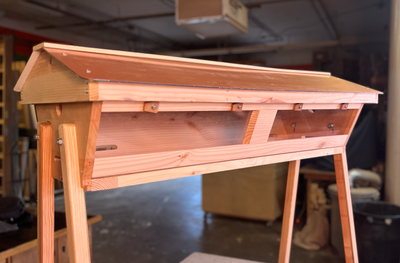Our Favorite Hives for Spring Beekeeping
Our Favorite Hives for Spring Beekeeping
By Taryn Murphy
Spring is coming, and we know you’re looking for the perfect hive to launch into beekeeping season. From our hands-on experience (and some trial and error) in the world of beekeeping products, we’ve grown to love these two hives: the Warré Hive from our friends at Rebel Bees and the Top Bar Hive from Backyard Hive.
Read on to learn why they’ve become our favorites and decide which one is right for you.
The Top Bar Hive
The top bar hive is the oldest and most commonly used hive style in the world. It features individual bars laid across the top of the hive cavity, on which bees naturally build their comb without a 4-sided frame or foundation.
With a horizontal top bar hive, beekeepers don’t have to lift heavy boxes, purchase an expensive honey extractor, use foundation full of chemicals, or overly agitate the bees when managing the colony. The heaviest comb you’ll need to lift with a top bar hive is a single 3-7 pound, honey-laden top bar (compared to a 50 pound box or super in other hive styles). Top bar hives do not require honey supers, extra frames, foundation, queen excluders, uncapping knives, extractors or other expensive tools.
Other benefits of a top bar hive include:
- Combs are easy to remove
- Simple honey harvest
- Quick inspections and easy management
- Bees are more docile during inspections since only small portions of the hive are being opened at a time
Our favorite top bar hive is the Golden Mean Hive, crafted by our friends at Backyard Hive. After noticing how productive bees were in hives built in the “Golden Mean” proportion, Corwin Bell developed this hive which inspires productive and healthy hive colonies.
To get 10% off your purchase of the Golden Mean Hive, use our code BEEBUILT at checkout.
The Warré Hive
The Warré Hive uses bars similar to that of a top bar hive, but is vertically stacking. It incorporates natural comb, the retention of nest scent and heat, and mimics the honeybee’s ideal natural environment.
Abbé Émile Warré (France, 1867-1951) developed the "People’s Hive", today commonly named the Warré hive. His work is the result of research on 350 hives from different systems, combined with observation of the bees' natural behavior.
In Warré's book, titled Beekeeping for All, he wrote:
''For more than thirty years I have studied in my apiaries the main hive systems shown in the illustrations reproduced here. I have in my apiaries 350 hives of different systems. I have been able to make comparisons...I will simply give you the reasons for their superiority, reasons based on incontestable apicultural and scientific principles.'' (Beekeeping for All, 12 ed., trans. David and Pat Heaf, pg. 25)
Warré hives are ideally suited for the beekeeper looking for a low-cost, low-maintenance hive design. With a Warré hive, beekeepers needn’t frequently inspect the colony, purchase an expensive honey extractor or use chemical-laden foundation. The practice of “nadiring” in Warré hives (adding extra boxes to the bottom of the stack) helps to cycle old comb out of use, preventing build-up of environmental and agricultural toxins.
At Bee Built, we've used these hives for over a decade and find them to be the most hands-off, natural design.
Other benefits of a Warré hive include:
- Simple management by the box rather than by the comb
- Lighter boxes
- Optional windows
- Foundationless
Our favorite Warré hive is made by Rebel Bees, and comes with a window option.
Whichever hive you choose, we wish you a happy and successful beekeeping season. Bees are forgiving creatures--they’ve been doing their thing for millennia. Just pick your favorite hive and they’ll take care of the rest!





